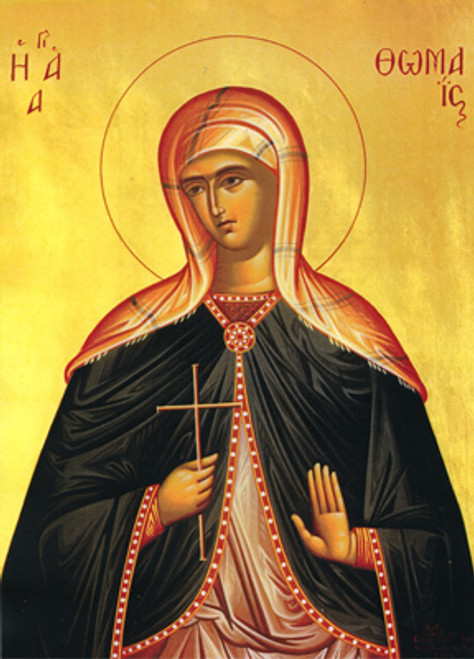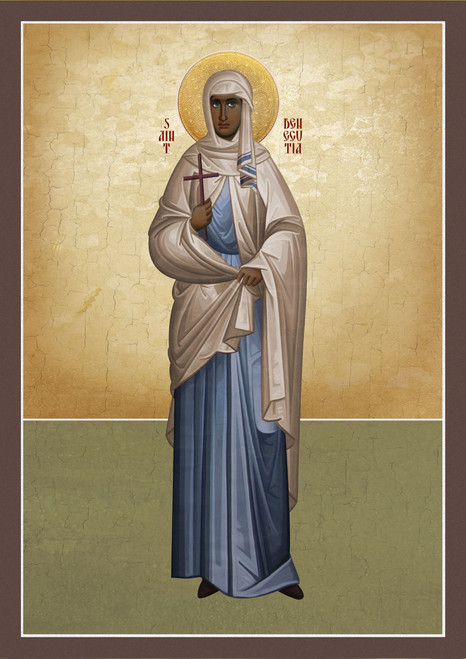Commemorated on Dec. 16
Adelaide of Italy (German: Adelheid; 931 – 16 December 999 AD), also called Adelaide of Burgundy, was Holy Roman Empress by marriage to Emperor Otto the Great;[2] she was crowned with him by Pope John XII in Romeon 2 February 962. She was regent of the Holy Roman Empire as the guardian of her grandson in 991–995.[2]
Early life
Born in Orbe Castle, Orbe, Kingdom of Upper Burgundy(now in modern-day Switzerland), she was the daughter of Rudolf II of Burgundy, a member of the Elder House of Welf, and Bertha of Swabia.[3]
She became involved from the beginning in the complicated fight to control not only Burgundy but also Lombardy. The battle between her father Rudolf II and Berengar I to control northern Italy ended with Berengar's death, and Rudolf could claimed the throne.[4]
However, the inhabitants of Lombardy weren't happy with this decision and called for help of another ally, Hugh of Provence, who considered Rudolf an enemy for a long time. Although Hugh challenged Rudolf for the Burgundian throne, he only succeeded when Adelaide's father died in 937,[4] and in order to be able to control Upper Burgundy he decided to marry his son Lothair II, the nominal King of Italy,[5] with Adelaide (in 947, before 27 June) who was 15 years old.
The marriage produced a daughter, Emma of Italy, born about 948. She became Queen of Western France by marrying King Lothair of France.
Empress
The Calendar of Saints states that her first husband was poisoned, on 22 November 950 in Turin, by the holder of real power, his successor, Berengar II of Italy.
Not only did some people of Lombardy suggest that Adelaide wanted to rule the kingdom by herself, but Berengar attempted to cement his political power by forcing her to marry his son, Adalbert. The young widow refused and fled, taking refuge in the castle of Como. Nevertheless, she was quickly tracked down and imprisoned for four months at Garda.
According to Adelaide's contemporary biographer, Odilo of Cluny, she managed to escape from captivity. After a time spent in the marshes nearby, she was rescued by a priest and taken to a "certain impregnable fortress," likely the fortified town of Canossa Castle near Reggio. She managed to send an emissary to Otto I, and asked the East Frankish king for his protection. The widow met Otto at the old Lombard capital of Pavia and they married on 23 September 951.
A few years later, in 953, Liudolf, Duke of Swabia, Otto's son by his first marriage, made a big revolt against his father that was quelled by the latter. On account of this episode, Otto decided to dispossess Liudolf of his ducal title. This decision favoured the position of Adelaide and her descendants at court. Adelaide also managed to retain her entire territorial dowry.
After returning to Germany with his new wife, Otto cemented the existence of the Holy Roman Empire by defeating the Hungarian invaders at the Battle of Lechfeld on 10 August 955. In addition, he extended the boundaries of East Francia beyond the Elbe River, defeating the Obrodites and other Slavs of the Elbe at the battle of Recknitz (16 October 955).
Adelaide accompanied her husband on his second expedition to Italy, destined to subdue the revolt of Berengar II and to protect Pope John XII. In Rome, Otto the Great was crowned Holy Roman Emperor on 2 February 962 by Pope John XII and breaking tradition, also crowned Adelaide as Holy Roman Empress. Four years later, Adelaide and their eleven-year-old son, Otto II, traveled again with Otto in 966 on his third expedition to Italy, where the Emperor restored the newly elected Pope John XIII to his throne (and executed some of the Roman rioters who had deposed him).
Adelaide remained in Rome for six years while Otto ruled his kingdom from Italy. Their son Otto II was crowned co-emperor in 967, then married the Byzantine princess Theophanu in April 972, resolving the conflict between the two empires in southern Italy, as well as ensuring the imperial succession. Adelaide and her husband then returned to Germany, where Otto died in May 973, at the same Memleben palace where his father had died 37 years earlier.
Regency
In the years following Otto's death, Adelaide exerted a powerful influence at court. However, her daughter-in-law, the Byzantine princess Theophanu, turned her husband against her and Adelaide was expelled from court in 978. During her exile, she divided her time living partly in Italy and partly in Arles with her brother Conrad of Burgundy, King of Burgundy, through whom she was finally reconciled with her son; in 983 (shortly before his death) Otto II appointed her his viceroy in Italy.
In 983, her son Otto II died and was succeeded by her grandson Otto III under the regency of his mother Adelaide's daughter-in-law Dowager Empress Theophanu while Adelaide remained in Italy. When Theophanu died in 990, Adelaide assumed regency on behalf of her grandson the Emperor until he reached legal majority four years later. Adelaide resigned as regent when Otto III was declared of legal majority in 995 and from then on devoted herself exclusively to her works of charity, in particular to the foundation and restoration of religious houses: monasteries, churches and abbeys.
On her way to Burgundy to support her nephew Rudolf III against a rebellion, she died at Selz Abbey on 16 December 999, days short of the millennium she thought would bring the Second Coming of Christ. She was buried in the Abbey and Pope Urban II canonized her in 1097. Although after serious flooding, which almost completely destroyed it in 1307, Adelaide's relics, miraculously saved, were moved to the parish church in the town of Seltz, dedicated to Stephen, where they now rest
Adelaide had constantly devoted herself to the service of the church and peace, and to the empire as guardian of both; she also interested herself in the conversion of the Slavs. She was thus a principal agent—almost an embodiment—of the work of the pre-schism Orthodox Catholic Church at the end of the Early Middle Ages in the construction of the religious culture of Central Europe. Some of her relics are preserved in a shrine in Hanover. Her feast day, 16 December, is still kept in many German dioceses.







